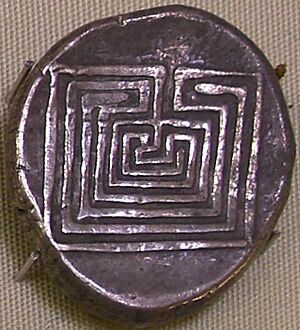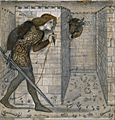Labyrinth facts for kids
The Labyrinth was a very clever building from ancient Greek stories. It was like a giant, confusing puzzle. A brilliant inventor named Daedalus built it for King Minos of Crete at Knossos.
The Labyrinth's main job was to hold a scary creature called the Minotaur. A hero named Theseus later defeated the Minotaur. Daedalus made the Labyrinth so tricky that even he had trouble finding his way out after finishing it!
Contents
Labyrinths and Mazes
In everyday English, the word labyrinth often means the same thing as maze. However, many experts and fans of these designs see a difference.
A maze is a complex puzzle. It has many paths, choices, and dead ends. You have to make decisions about which way to go to find your way through it.
A labyrinth, on the other hand, usually has only one path. This single path winds and turns, but it always leads directly to the center. There are no choices to make, and no dead ends. It's not a puzzle to solve, but more like a journey to walk.
Labyrinths Through History
People have used unicursal labyrinths (the single-path kind) for thousands of years. You can find them as designs on old pottery or basketry. Some ancient people even used them as body art or carved them into cave walls and churches.
The ancient Romans often used labyrinths as decorations. They made beautiful designs on walls and floors using tiles or mosaics. Many labyrinths built on floors or in fields are big enough for people to walk through them.
Modern Uses of Labyrinths
Today, labyrinths are still used in many ways. Historically, they were used for group rituals or for private meditation. Walking a labyrinth can help people relax and focus their thoughts. Because of this, you can now find labyrinths in hospitals and hospices. They are used to help people feel calmer and heal.
Images for kids
-
Theseus in the Minotaur's labyrinth, by Edward Burne-Jones, 1861
-
Carving showing the warrior Abhimanyu entering the chakravyuha – Hoysaleswara temple, Halebidu, India
-
Chartres Cathedral, about 1750, Jean Baptiste Rigaud
-
Labyrinth on floor of Grace Cathedral, San Francisco.
See also
 In Spanish: Laberinto para niños
In Spanish: Laberinto para niños









